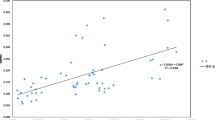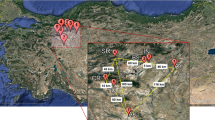Abstract
Saruma henryi Oliv., the only representative of the monotypic genus Saruma Oliv. (Aristolochiaceae), is an endangered perennial herb endemic to China. It is a phylogenetically, ecologically, and medicinally important species. In the present study, inter-simple sequence repeat (ISSR) markers were employed to investigate the genetic diversity and differentiation of 14 populations. A total of 16 selected primers yielded 175 bright and discernible bands, with an average of 10.94 per primer. POPGENE analysis showed that the genetic diversity was quite low at the population level (h = 0.0447–0.1243; I = 0.0642–0.1853; PPB = 10.29–36.57%), but pretty high at the species level (h = 0.2603; I = 0.3857; PPB = 73.71%). The hierarchical analysis of molecular variance (AMOVA) revealed a high level of genetic differentiation among populations (67.18% of total variance components, P < 0.001), in line with the gene differentiation coefficient (G ST = 0.6903) and the limited among-population gene flow (N m = 0.2243). Both Principal Coordinates Analysis (PCoA) and UPGMA cluster analysis supported the grouping of all 14 populations into three geographic groups, among which there occurred a moderate level of genetic differentiation (33.18% of total variance components, P < 0.001) as shown by AMOVA analysis. In addition, Mantel test revealed a significant correlation between genetic and geographic distances among populations (r = 0.7792, P = 0.001), indicating the role of geographic isolation in shaping its present population genetic structure. The present levels and patterns of genetic diversity of S. henryi were assumed to result largely from its breeding system, geographic isolation, clonal growth, its unique biological traits and evolutionary history. The high genetic differentiation among populations implies that the conservation efforts should aim to preserve all the extant populations of this endangered herb.




Similar content being viewed by others
References
Avise JC, Hamrick JL (1996) Conservation genetics: case histories from nature. Chapman and Hall, New York
Cao P-J, Yao Q-F, Ding B-Y, Zeng H-Y, Zhong Y-X, Fu C-X, Jin X-F (2006) Genetic diversity of Sinojackia dolichocarpa (Styracaceae), a species endangered and endemic to China, detected by inter-simple sequence repeat (ISSR). Biochem Syst Ecol 34:231–239. doi:10.1016/j.bse.2005.11.001
Cheng C-Y, Yang C-S, Hwang S-M (1988) Aristolochiaceae. In: Kiu H-S, Ling Y-R (eds) Flora Reipublicae Popularis Sinicae. vol 24, Science Press, Beijing, pp 159–245 (in Chinese with English abstract)
Di W-Z, Yu Z-Y (1989) State-protected rare and endangered plants in Shaanxi Province. Northwest University Press, Xi’an (in Chinese)
Dickison WC (1996) Stem and leaf anatomy of Saruma henryi Oliv, including observations on raylessness in the Aristolochiaceae. Bull Torrey Bot Club 123:261–267. doi:10.2307/2996773
Doyle JJ, Doyle JL (1987) A rapid DNA isolation procedure for small quantities of fresh leaf tissue. Phytochem Bull 19:11–15
Erickson DL, Hamrick JL (2003) Genetic and clonal diversity for Myrica cerifera along a spatiotemporal island chronosequence. Heredity 90:25–32. doi:10.1038/sj.hdy.6800172
Excoffier L, Smouse PE, Quattro JM (1992) Analysis of molecular variance inferred from metric distances among DNA haplotypes: application to human mitochondrial DNA restriction data. Genetics 131:479–491
Excoffier L, Laval G, Schneider S (2005) Arlequin (version 3.0): an integrated software package for population genetics data analysis. Evol Bioinform Online 1:47–50
Feyissa T, Nybom H, Bartish I, Welander M (2007) Analysis of genetic diversity in the endangered tropical tree species Hagenia abyssinica using ISSR markers. Genet Resour Crop Evol 54:947–958. doi:10.1007/s10722-006-9155-8
Futuyma DJ (1986) Evolutionary biology. Sinauer Associates, Sunderland, MA, USA
Gorman GC, Renzi J Jr (1979) Genetic distance and heterozygosity estimates in electrophoretic studies: effects of sample size. Copeia 1979:242–249. doi:10.2307/1443409
Gregory MP (1956) A phyletic rearrangement in the Aristolochiaceae. Am J Bot 43:110–122. doi:10.2307/2438819
Hamrick JL, Godt MJW (1989) Allozyme diversity in plant species. In: Brown AHD, Clegg MT, Kahler AL, Weir BS (eds) Plant population genetics. breeding and germplasm resources. Sinauer Associates, Sunderland, MA, USA, pp 43–63
Hamrick JL, Godt MJW (1996a) Conservation genetics of endemic plant species. In: Avise JC, Hamrick JL (eds) Conservation genetics: case histories from nature. Chapman and Hall, New York, pp 281–304
Hamrick JL, Godt MJW (1996b) Effects of life history traits on genetic diversity in plant species. Philos Trans R Soc Lond B 351:1291–1298
Hsu E (2005) Saruma henryi Aristolochiaceae. Curtis’s Bot Mag 22:200–204. doi:10.1111/j.1355-4905.2005.00491.x
Igarashi S, Fukuda H (1997) The life histories of Asian butterflies. vol 1, Tokai University Press, Tokyo
Ingvarsson PK (2002) A metapopulation perspective on genetic diversity and differentiation in partially self-fertilizing plants. Evolution 56:2368–2373
Li S, Chang Z, Chen Y (1994a) Studies on conservation biology of Saruma henryi Oliv (in Chinese with English abstract). Acta Bot Boreal-Occident Sin 14:104–108
Li S, Chen Y, Wu Z, Ying T (1994b) Study on karyotype of Saruma Oliver (Aristolochiaceae) and its systematic significance (in Chinese with English abstract). Acta Bot Boreal-Occident Sin 14:143–146
Luan S, Chiang T-Y, Gong X (2006) High genetic diversity vs. low genetic differentiation in Nouelia insignis (Asteraceae), a narrowly distributed and endemic species in China, revealed by ISSR fingerprinting. Ann Bot (Lond) 98:583–589. doi:10.1093/aob/mcl129
Ma J-S (1990) The geographical distribution and the system of Aristolochiaceae (in Chinese with English abstract). Acta Phytotaxon Sin 28:345–355
Mantel N (1967) The detection of disease clustering and a generalized regression approach. Cancer Res 27:209–220
Miller MP (1997) Tools for population genetic analyses (TFPGA) 1.3: a Windows program for the analysis of allozyme and molecular population genetic data. Logan, Utah, USA
Nei M (1972) Genetic distance between populations. Am Nat 106:283–292. doi:10.1086/282771
Nei M, Roychoudhury AK (1974) Sampling variances of heterozygosity and genetic distance. Genetics 76:379–390
Neinhuis C, Wanke S, Hilu KW, Müller K, Borsch T (2005) Phylogeny of Aristolochiaceae based on parsimony, likelihood, and Bayesian analyses of trnL-trnF sequences. Plant Syst Evol 250:7–26. doi:10.1007/s00606-004-0217-0
Nybom H, Bartish IV (2000) Effects of life history traits and sampling strategies on genetic diversity estimates obtained with RAPD markers in plants. Perspect Plant Ecol Evol Syst 3:93–114. doi:10.1078/1433-8319-00006
Peakall ROD, Smouse PE (2006) GENALEX 6: genetic analysis in Excel. Population genetic software for teaching and research. Mol Ecol Notes 6:288–295. doi:10.1111/j.1471-8286.2005.01155.x
Peng Q, Zhao H, Zhang G-Z (2005) Pharmacognostic identification of Saruma henryi and differentiation of Asarum siebodii (in Chinese with English abstract). Chin Tradit Herbal Drugs 36:277–280
Pfeifer M, Jetschke G (2006) Influence of geographical isolation on genetic diversity of Himantoglossum hircinum (Orchidaceae). Folia Geobot 41:3–20. doi:10.1007/BF02805258
Pluess AR, Stöcklin J (2004) Population genetic diversity of the clonal plant Geum reptans (Rosaceae) in the Swiss Alps. Am J Bot 91:2013–2021. doi:10.3732/ajb.91.12.2013
Schaal BA, Hayworth DA, Olsen KM, Rauscher JT, Smith WA (1998) Phylogeographic studies in plants: problems and prospects. Mol Ecol 7:465–474. doi:10.1046/j.1365-294x.1998.00318.x
Slatkin M (1985) Gene flow in natural populations. Annu Rev Ecol Syst 16:393–430. doi:10.1146/annurev.ecolsys.16.1.393
Tamura K, Dudley J, Nei M, Kumar S (2007) MEGA4: Molecular Evolutionary Genetics Analysis (MEGA) software version 4.0. Mol Biol Evol 24:1596–1599. doi:10.1093/molbev/msm092
Templeton AR, Shaw K, Routman E, Davis SK (1990) The genetic consequences of habitat fragmentation. Ann Mo Bot Gard 77:13–27. doi:10.2307/2399621
Thorne RF (1974) A phylogenetic classification of the Annoniflorae. Aliso 8:147–205
Tomimatsu H, Ohara M (2003) Genetic diversity and local population structure of fragmented populations of Trillium camschatcense (Trilliaceae). Biol Conserv 109:249–258. doi:10.1016/S0006-3207(02)00153-2
Williams JGK, Kubelik AR, Livak KJ, Rafalski JA, Tingey SV (1990) DNA polymorphisms amplified by arbitrary primers are useful as genetic markers. Nucleic Acids Res 18:6531–6535. doi:10.1093/nar/18.22.6531
Wolfe AD, Liston A (1998) Contributions of PCR-based methods to plant systematics and evolutionary biology. In: Soltis DE, Soltis PS, Doyle JJ (eds) Molecular systematics of plants. II. DNA sequencing. Kluwer, Norwell, pp 43–86
Wright S (1943) Isolation by distance. Genetics 28:114–138
Xiao L-Q, Ge X-J, Gong X, Hao G, Zheng S-X (2004) ISSR variation in the endemic and endangered plant Cycas guizhouensis (Cycadaceae). Ann Bot (Lond) 94:133–138. doi:10.1093/aob/mch119
Yeh FC, Yang R-C, Boyle TBJ, Ye Z-H, Mao JX (1997) POPGENE, The user-friendly shareware for population genetic analysis. Molecular Biology and Biotechnology Centre, University of Alberta, Canada
Ying J-S, Zhang Y-L (1994) Seed plant genera endemic to China. Science Press, Beijing
Yu Z-Y, Li S-F (1989) Preliminary study on the rare and endangered plant species in Qinling-Bashan Mountains. In: Shaanxi Academy of Sciences (ed) Biological resources in Qinling mountains and their exploitation. Scientific and Technical Documents Publishing House, Beijing, pp 5–32 (in Chinese)
Zhang FM, Ge S (2002) Data analysis in population genetics. I. Analysis of RAPD data with AMOVA. Biodivers Sci 10:438–444 (in Chinese with English abstract)
Zhao H, Yang P-J, Peng Q (2005) Biological study of pistil morphology and pollination of Saruma henryi (in Chinese with English abstract). Acta Bot Boreal-Occident Sin 25:923–927
Acknowledgments
The authors would like to thank three anonymous reviewers for their critical comments on the manuscript. This study was financially co-supported by the National Natural Science Foundation of China (Grant No: 30800087), the Program for Changjiang Scholars and Innovative Research Team in University (PCSIRT) and the Postgraduate Innovation & Education Program of Northwest University (NWU) (Grant No: 08YZZ37).
Author information
Authors and Affiliations
Corresponding author
Rights and permissions
About this article
Cite this article
Zhou, TH., Qian, ZQ., Li, S. et al. Genetic diversity of the endangered Chinese endemic herb Saruma henryi Oliv. (Aristolochiaceae) and its implications for conservation. Popul Ecol 52, 223–231 (2010). https://doi.org/10.1007/s10144-009-0139-3
Received:
Accepted:
Published:
Issue Date:
DOI: https://doi.org/10.1007/s10144-009-0139-3




